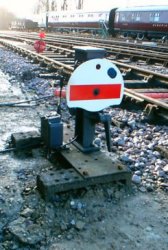

|


|

|
|
Signalling & Telecoms: - Signals - Signal Boxes - Diagrams for East Grinstead - Kingscote - Horsted Keynes - Sheffield Park Bell Codes - Staff Instruments - Key-Token Instruments - Walkers Train Describers - Horsted Keynes Re-signalling 

Horsted Keynes Re-Signalling
|
||||||||||||||||||||||||||||||||||||||||||||||||||||
 |
The latest signal to be commissioned is the temporary Stop Board
controlling the exit from Platform Nº1 towards the Ardingly siding. This
signal will, of course, be replaced by a semaphore arm in due course. Photograph: Chris Majer |
Third Quarter 2002
Work continues to be mainly "behind the scenes" although one or two indications of further progress are to be seen by the keen observer. The Alf Brown gang is making good progress with the new signals, work not always visible until finished, but due to movement of stock in the siding behind the Signalbox they were performing in public recently should anyone have looked in the correct direction as their train arrived or departed the station.
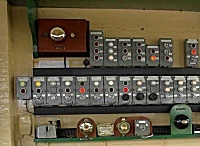 Yet another signal has been re-commissioned. On 3
August the up outer distant (just "the up distant" on the old layout)
was brought into use. This is one of the signals that is not lever controlled
but works automatically when the outer home signal is pulled off, provided a
train has not already passed the site of the outer distant. With the sharp
grade by the outer home signal this advance warning that the signal may well be
"on" will allow a driver to slow his approach in the hope that he
won't have to stop and re-start his train on the 1 in 75 grade. The
left-most repeater in the photograph shows green to indicate the outer distant
is off.
Yet another signal has been re-commissioned. On 3
August the up outer distant (just "the up distant" on the old layout)
was brought into use. This is one of the signals that is not lever controlled
but works automatically when the outer home signal is pulled off, provided a
train has not already passed the site of the outer distant. With the sharp
grade by the outer home signal this advance warning that the signal may well be
"on" will allow a driver to slow his approach in the hope that he
won't have to stop and re-start his train on the 1 in 75 grade. The
left-most repeater in the photograph shows green to indicate the outer distant
is off.
Photograph: Chris Majer
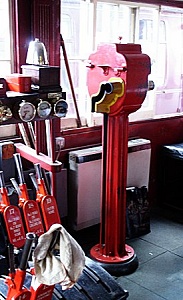 One of the operational
problems of single lines is the unequal use of the single line tokens. On the
Bluebell it is often the case that two engines will use two train staffs to
travel from Sheffield Park to Horsted Keynes as light engines in the morning,
but only bring one back in the evening, either through one making a
double-headed train or by the two light engines travelling together. In this
instance two staffs will have gone up to Horsted Keynes, but only one will have
returned. It is not difficult to see that this imbalance can quickly build up,
so when it does there is a procedure for removing some staffs from one
instrument and replacing them in the other, thereby evening out the
distribution. On Friday, 2 August, the traffic was such that every staff in the
Sheffield Park instrument was in use at one point during the day. This most
unusual occurrence is reflected in the photograph on the left which shows the
instrument with no staff in it. The staffs quickly came back again, and more
were transferred from Horsted Keynes, so that anyone looking in the Signalbox
on the Saturday would have seen a good number in situ.
One of the operational
problems of single lines is the unequal use of the single line tokens. On the
Bluebell it is often the case that two engines will use two train staffs to
travel from Sheffield Park to Horsted Keynes as light engines in the morning,
but only bring one back in the evening, either through one making a
double-headed train or by the two light engines travelling together. In this
instance two staffs will have gone up to Horsted Keynes, but only one will have
returned. It is not difficult to see that this imbalance can quickly build up,
so when it does there is a procedure for removing some staffs from one
instrument and replacing them in the other, thereby evening out the
distribution. On Friday, 2 August, the traffic was such that every staff in the
Sheffield Park instrument was in use at one point during the day. This most
unusual occurrence is reflected in the photograph on the left which shows the
instrument with no staff in it. The staffs quickly came back again, and more
were transferred from Horsted Keynes, so that anyone looking in the Signalbox
on the Saturday would have seen a good number in situ.
 The bracket for the new
signals Nº6 and Nº7 is progressing well and can be seen on the right.
These signals should be commissioned before the end of September, at which time
the temporary Nº7 signal and Nº24A position light signal will be
removed, thereby freeing up the trackbed for the completion of the new dock
road.
The bracket for the new
signals Nº6 and Nº7 is progressing well and can be seen on the right.
These signals should be commissioned before the end of September, at which time
the temporary Nº7 signal and Nº24A position light signal will be
removed, thereby freeing up the trackbed for the completion of the new dock
road.
Photograph: Chris Majer
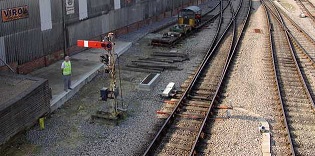 On the left is the present
post carrying signal Nº7 and position light signal Nº24A, as viewed
from the gantry of the new signal!
On the left is the present
post carrying signal Nº7 and position light signal Nº24A, as viewed
from the gantry of the new signal!
Photograph: Chris Majer
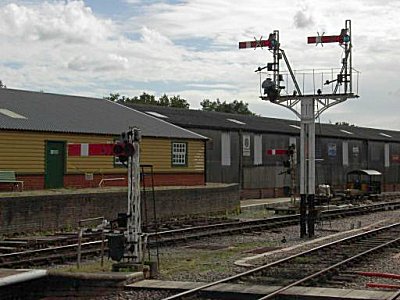 Another of the sights you won't normally see on
the Bluebell is the out-of-use signal arm, denoted by a white "X", as
it is not the Railway's policy to use such things. If a signal is not in
use then the arm should be removed. However, on 8 September the arms for the
new numbers 6 and 7 signals were temporarily placed in position for sighting
purposes, and as they were not in use they had to carry the white
"X". Once the sighting had been checked the arms were removed again,
but not until a couple of trains had passed this most unusual of Bluebell
sights! (The two signals to the left of the new bracket are the present
Nº6 and Nº7).
Another of the sights you won't normally see on
the Bluebell is the out-of-use signal arm, denoted by a white "X", as
it is not the Railway's policy to use such things. If a signal is not in
use then the arm should be removed. However, on 8 September the arms for the
new numbers 6 and 7 signals were temporarily placed in position for sighting
purposes, and as they were not in use they had to carry the white
"X". Once the sighting had been checked the arms were removed again,
but not until a couple of trains had passed this most unusual of Bluebell
sights! (The two signals to the left of the new bracket are the present
Nº6 and Nº7).
Photograph: Chris Majer
Fourth Quarter 2002
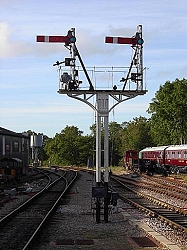
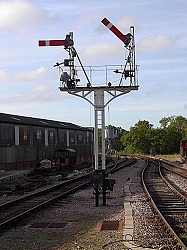 The final quarter of the year got
off to a very good start with the commissioning of the two new down platform
starters, Nº6 and Nº7, during the afternoon of Saturday, 5
October.
The final quarter of the year got
off to a very good start with the commissioning of the two new down platform
starters, Nº6 and Nº7, during the afternoon of Saturday, 5
October.
The left-hand picture shows the two arms at danger, with the temporary position
light signal at the base of the left-hand post showing clear for a shunt move
from Nº4 road towards the down yard. In the right-hand picture signal
Nº6 indicates the road is clear from Nº3 road to the advanced
starter.
Photographs: Chris Majer
The finials, which are reproductions, were painted white instead of grey and have been sent for a repaint.
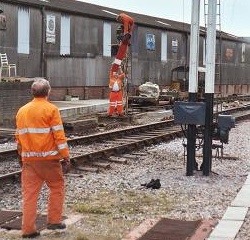
As always, when it's in with the new, it's out with the old! The
picture on the right shows the old Nº7 signal being dismantled just after
the new one was commissioned. The signal arm is being handed down, no
lightweight job as they are very heavy, partly due to the weight of the
spectacle plate casting!
Photograph: Adrian Lee
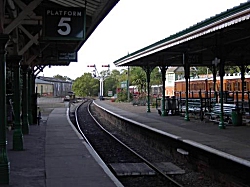
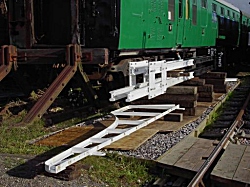 This left-hand picture shows the new
signals from halfway along platform Nº5 whilst in the right-hand picture
beside Nº1 road is the structure for the new Nº8 signal which is
planned to go up later this month at the south end of platform Nº2.
This left-hand picture shows the new
signals from halfway along platform Nº5 whilst in the right-hand picture
beside Nº1 road is the structure for the new Nº8 signal which is
planned to go up later this month at the south end of platform Nº2.
Photographs: Chris Majer
On 9 November a banner signal on platform four and an "OFF" indicator for platform five were commissioned. These are needed as either the canopy and/or a train in Nº4 road can obscure sighting of the down starters, a problem resolved by these. When the down starter for Nº4 road is off, the banner repeater will rotate to imitate a semaphore arm and the "OFF" indicator will illuminate. The banner signal will only be used in conjunction with the down starter, but it is possible that sometime in the future by use of additional "UP" and "DOWN" indicators the platform five "OFF" indicator could be used for up trains as well as down ones.
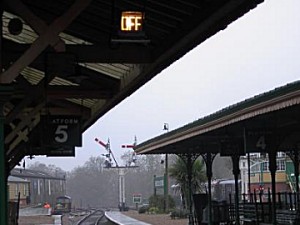
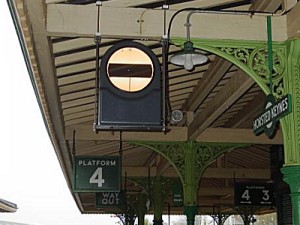 On the left is the "OFF"
indicator and on the right the banner signal.
On the left is the "OFF"
indicator and on the right the banner signal.
Photographs: Chris Majer
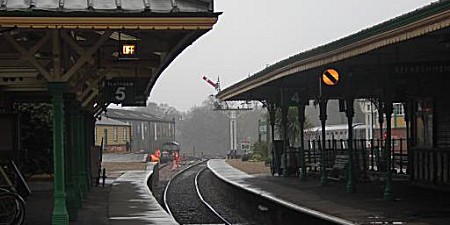 On the left can be seen both the "OFF"
indicator illuminated and the banner off in conjunction with the starting
signal at the end of the platform being off. If you look closely you will see
that the finials for 6/7 signals are now in place.
On the left can be seen both the "OFF"
indicator illuminated and the banner off in conjunction with the starting
signal at the end of the platform being off. If you look closely you will see
that the finials for 6/7 signals are now in place.
Photograph: Chris Majer
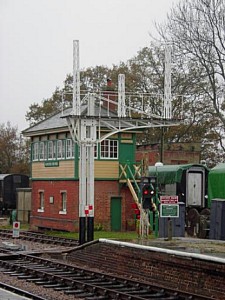 On the right can be seen the bracket signal post
for platform 1 & 2 down starters is in position. The left doll will be a
full arm for 8A signal. The short doll will be a ringed short arm for shunting
to the Ardingly branch as will the signal on the right doll applying to
platform 1 (until such time as the branch is reopened).
On the right can be seen the bracket signal post
for platform 1 & 2 down starters is in position. The left doll will be a
full arm for 8A signal. The short doll will be a ringed short arm for shunting
to the Ardingly branch as will the signal on the right doll applying to
platform 1 (until such time as the branch is reopened).
In the short term the 8A and the position light signal will go on the gantry so
that the temporary post can be removed.
Photograph: Chris Majer
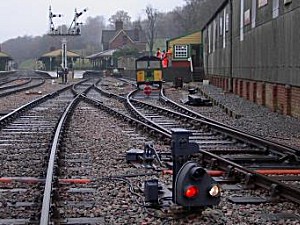 The Dock siding is almost complete and 26B route
(from Down yard to the Dock siding) will be commissioned soon. The exit signal
from the dock will be a non-commissioned mechanical shunt requiring authority
to pass until the lever frame is commissioned, at which time the position light
signal will be replaced with a proper Southern disk shunt signal.
The Dock siding is almost complete and 26B route
(from Down yard to the Dock siding) will be commissioned soon. The exit signal
from the dock will be a non-commissioned mechanical shunt requiring authority
to pass until the lever frame is commissioned, at which time the position light
signal will be replaced with a proper Southern disk shunt signal.
Photograph: Chris Majer
And here is that non-commissioned mechanical shunt signal,
photographed by Jon Bowers on 1 December.
First Quarter 2003
This is a bit of a cheat really as the work was done in December! However, January 1st saw the new Nº8 signal moved onto the main post of the new bracket signal at the end of platforms 1 & 2 and the Dock Road both in use.
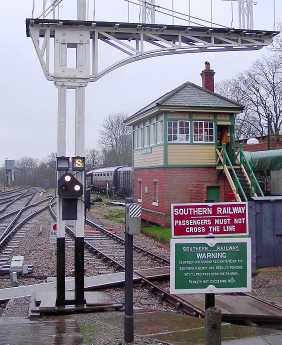
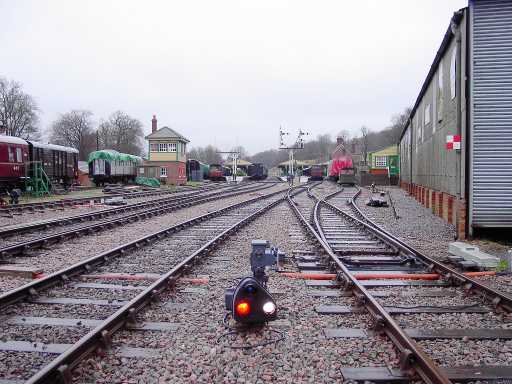
Photographs: Chris Majer
The photo on the left shows the route set for the Ardingly road and the photo on the right is of the Dock Road with a Wickham Trolley in situ.
Main activity during January centred around the north end of the station, getting the new location cases and through cables installed. The location cases are being wired up outside the Signalbox and trolleyed to their site. For example loc. HK10 was finished on Sunday and taken to its site at Horsted House farm where it will work the new outer home (and distant) No. 1 signal. Also waiting for the new Inner Home signal No.4 to be erected is the double width theatre type route indicator that can display platforms 1-4 as well as T(hrough) and L(oop) for the main and alternative routes.
Text from Chris Majer
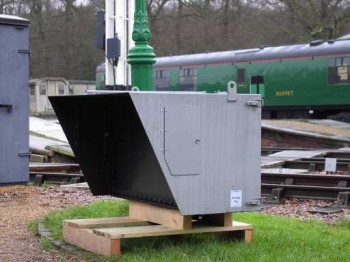
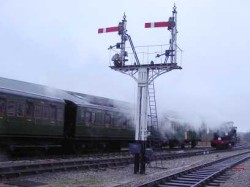 Left: The theatre
type route indicator outside Horsted Signalbox.
Left: The theatre
type route indicator outside Horsted Signalbox.
Right: As can be seen, full use is being made of the new Dock Road! Here
it is occupied by the Vintage Train Carriages as Normandy passes whilst
shunting.
The weekend of 15/16 March saw a lot of activity on the Permanent Way front as they commenced operations to slew the Ardingly siding over and extend the running line up to the missing viaduct. The stock had to be dispersed around the station yard to allow the track to be moved and was put back during the Monday Shunt.
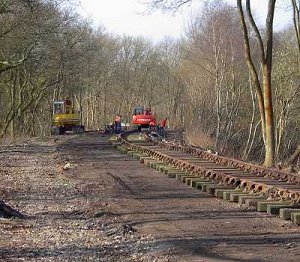
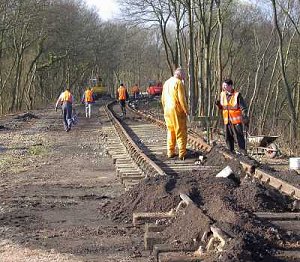 Work in progress slewing
the track across to the righthand side of the foundation.
Work in progress slewing
the track across to the righthand side of the foundation.
The S&T continue to install the new location boxes at the London end of Horsted and the new Down Inner Home is being assembled outside the box ready to go to site. This is the signal that has the new double width theatre type route indicator mounted on it.
Photograph: Adrian Lee
Second Quarter 2003
On 1 April "TPWS" was fitted to signal Nº6. The date alone
should have been a sufficient give-away that this was a wind-up, but many fell
for it!
The S&T are busy installing the new location boxes towards Kingscote and
have prepared the track circuits and signal controls ready for the changeover,
whilst the new through cables are sitting in a wagon in platform 1 (the cables
won't be run out until the new troughing route to Horsted House Farm is
complete).
The Ardingly branch has had the siding relaid but the through line is awaiting
the preparation of the track bed. The photo of the end of the track bed shows
the extent of the problem! Something akin to the edge of a precipice.
A level crossing has been installed for works access to the Ardingly branch
site
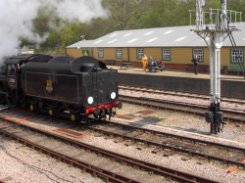 |
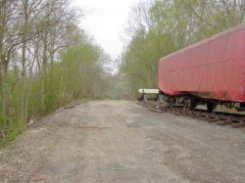 |
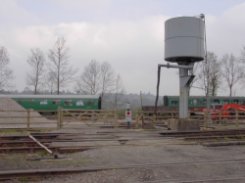 |
| Camelot approaches the "TPWS" fitted signal. | The Ardingly trackbed. | The Ardingly level crossing gates. |
| Text and photographs: Chris Majer | ||
| The new double width theatre type route indicator installed on what will be
the Down Inner Home Signal. This is already attracting comments such as
"Cinemascope"... etc! The new troughing that is being installed can be clearly seen here. Photograph: Jon Bowers |
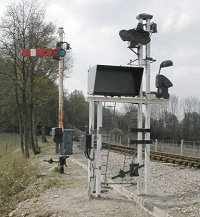 |
7 June saw the end of an era at the Bluebell Railway. On that date Charles Hudson and his team brought in the next phase of the Horsted Keynes re-signalling and the old Fixed Down Distant, the last paraffin lit signal on the Bluebell, was abolished. Adrian Lee, aka Paraffin Pete, is pictured, fag in hand, tending the lamp for the last time. Does anyone have a job for a man with an addiction to paraffin? There is also a picture of the signal - the camera is level but the post is not vertical as it leant to the West and the North (and the ladder was difficult to climb as a result). The post was removed with surprisingly great difficulty on 7 June and all that remains is a hole in the ground (starter homes for the bunnies that plague the area).
 |
Left: Unemployed lampman!
Right: The leaning signal post |
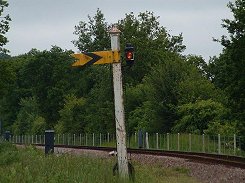 |
The new Down Distant (Fixed at Caution for the time being) is pictured with a white cross on the arm to show that it is not in use, shortly before 7 June. This signal will become the Down Inner Distant when the final phase of the re-signalling takes place. On the rail built post can also be seen (wrapped in black plastic) the fittings for what is to be the Down Outer Home. These will be co-acting arms, the lower for sighting by Loco Crews at close range, and the upper for sighting against the sky at a greater distance. The post is several hundred yards further North than the existing Down Distant, on the other side of Horsted House Farm Bridge.
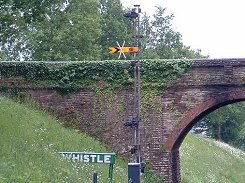 |
Left: The Down Distant shortly before being commissioned
Right: A more "distant" view! |
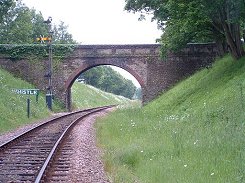 |
The Down Home was also abolished and replaced with a new signal, with 'Wide Screen TV' route Indicator. This can only display '3' at present, as this is the only signalled route available. Further programmes will be available later, when the signal will become the Down Inner Home. There is a picture showing the new signal with white crosses alongside the old still in use and later one showing the new signal with route indication illuminated, with the stripped post behind, taken after the change over.
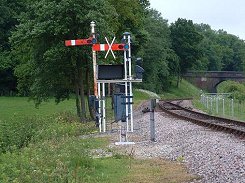 |
Left: The Down Home with a temporary white cross, before
being commissioned
Right: Now open for business with just the old post behind |
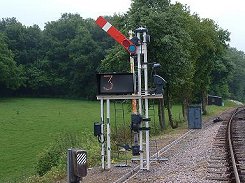 |
Text and photographs: Adrian Lee
It is not just the signals that are progressing, inside the Signalbox the
first instruments have been put on the block shelf and the lever frame tappets,
which are all new and ready for cutting, have been installed.
The instrument with 2 Tyers galvanometers is in preparation for the long
section working which will allow Horsted to close out. When Kingscote and
Sheffield Park give a release simultaneously, the Horsted signalman will be
able to move the King lever half way thus releasing the opposing locking
through Nº3 Road. When the route and signals have been set correctly the
Anetts key release next to the Up Outer Distant will be operated to get the
long section token section in-phase, thus completing the process. The up and
down route indicators on the Home signals will normally be unlit when Horsted
is closed out, but will light as a train approaches before the signal is
visible to the driver.
The points operated electrically have illuminated indicators showing N or R. This is all very much like a typical Southern signal box which had been partially transferred to power operation.
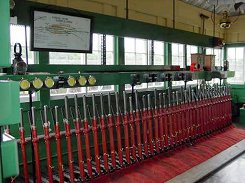 |
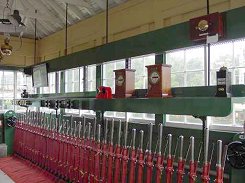 |
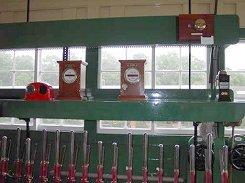 |
| The Block Shelf showing the instruments installed so far. | The long section switching-out instruments. | |
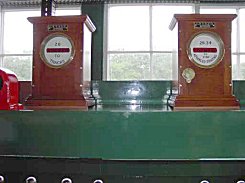 |
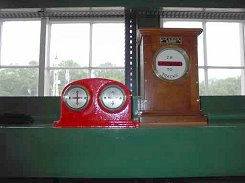 |
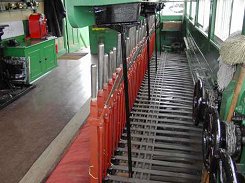 |
| The Sykes instruments will be used as indicators. | The twin galvanometer instrument. | The new tappets attached to the levers. |
| Text and photographs: Chris Majer | ||
Third Quarter 2003
Progress during August included placing the dolls (upper posts) on the bracket gantry at the south end of platforms 1 and 2, and applying signals 8A, 8B and 10, ready for connection to the lever frame. These will be wire operated. Progress with wiring up of the block shelf for all the instruments continues although the previous Train Arrived Complete instrument, which looked as if it were from the servants' quarters of a stately home, will sadly be replaced by a lamp on the minature illuminated diagram. The TAC will be used so that the station staff can advise the Signalman that a train is complete with tail lamp without having to ring the Signalbox.
 |
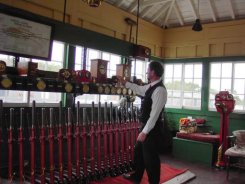 |
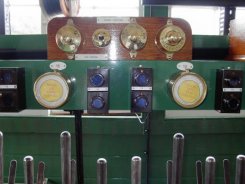 |
| The dolls on the bracket signal. | The photographer photographed! | Block shelf instruments. |
| Text and photographs: Chris Majer | ||
Recent activity has been concentrated on the relay room and around the station yard. The bracket signal at the south end of platforms one and two has had the temporary position light signal moved up to give better visibility and to clear the signalpost of obstructions.
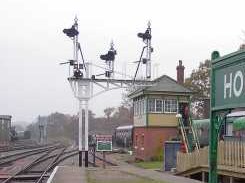 |
Left: The temporary position light signal, showing the
proceed aspect, raised up to its new home. Use your mouse to reveal the
identity of the signals that will be installed.
Right: The hook selector. Again, use your mouse to ascertain the workings. |
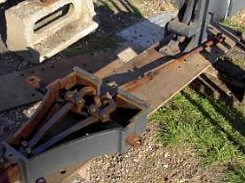 |
The preparation work for connecting the final mechanical arms for 8A and 8B to the lever frame involves the installation of a 'hook selector' on 22 points. This works by a bar from the points moving the hooks, the appropriate one then connects the wire from the lever in the Signalbox to the signal arm
Text and photographs: Chris Majer
On Saturday, 6 December, the arms were attached and the old Stop Board from Nº1 road towards the Ardingly siding was removed. All the arms are fixed at danger with moves from Nº2 road controlled by the position light signal and from Nº1 road towards the Ardingly siding by the Signalman giving specific authority to pass the signal at danger.
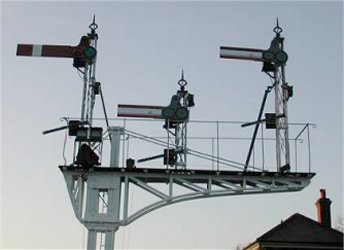 |
Two views of the completed bracket signals installed.
Photographs: Jon Bowers |
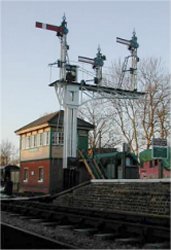 |


Return to BRPS Home Page, to the Timetable or to Special Events
Signalling & Telecoms: - Signals - Signal Boxes - Diagrams for East Grinstead - Kingscote - Horsted Keynes - Sheffield Park
Bell Codes - Staff Instruments - Key-Token Instruments - Walkers Train Describers - Horsted Keynes Re-signalling
Visitor Info. - Museum - Trust - Catering - Contacts - What's New - Projects - Locos - Carriages & Wagons - Signals - History - Other - Links - Search - FAQ
Why not become a BRPS Member? - Get more involved as a Volunteer
Content last updated 11 September 2006 by Peter Richards.
Last updated by Richard Salmon, 14 April 2022
© Copyright BRPS. Privacy Policy
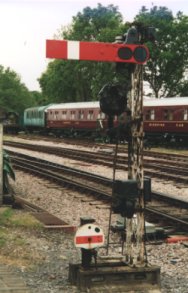 At the beginning of April the non-working starting
signal at the south end of Nº4 road was powered-up and commissioned on 12
April. This is a great improvement as far as all the signalmen are concerned as
they will no longer have to stand beside the signal in pouring rain with a flag
or lamp held out ready for the departure of the train that may, in the case of
the Pullman, be some ten or more minutes later leaving! (This signal,
pictured right, presently has a non-working dummy protecting movements into the
down yard. A temporary position light signal, worked from the 'box, will
soon be commissioned and is behind the black plastic sheeting that can be seen
a little below the main arm.)
At the beginning of April the non-working starting
signal at the south end of Nº4 road was powered-up and commissioned on 12
April. This is a great improvement as far as all the signalmen are concerned as
they will no longer have to stand beside the signal in pouring rain with a flag
or lamp held out ready for the departure of the train that may, in the case of
the Pullman, be some ten or more minutes later leaving! (This signal,
pictured right, presently has a non-working dummy protecting movements into the
down yard. A temporary position light signal, worked from the 'box, will
soon be commissioned and is behind the black plastic sheeting that can be seen
a little below the main arm.)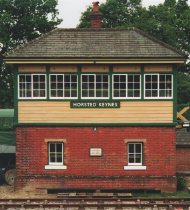
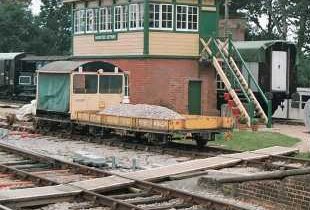
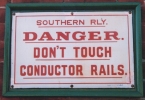
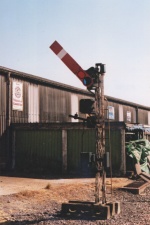
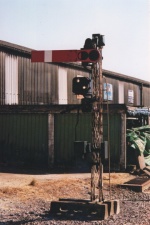
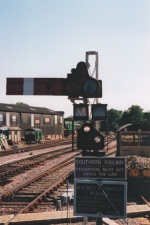
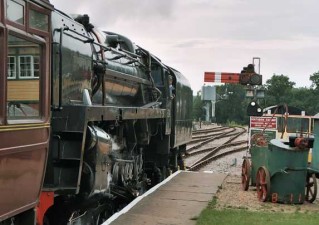
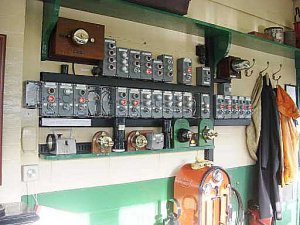 The S&T have been busy installing the track
circuits from the single line up through the station as far as the north end
whilst the work on the installation of the temporary panel switches and track
circuit indicators has been progressing all year and as can be seen from the
picture, (photograph: Chris Majer) on the right,
is now almost complete. Once the lever frame is re-connected these switches
will, of course, be dismantled with the track circuit indications being moved
to the Signalbox Diagram, which will be some nine feet long!
The S&T have been busy installing the track
circuits from the single line up through the station as far as the north end
whilst the work on the installation of the temporary panel switches and track
circuit indicators has been progressing all year and as can be seen from the
picture, (photograph: Chris Majer) on the right,
is now almost complete. Once the lever frame is re-connected these switches
will, of course, be dismantled with the track circuit indications being moved
to the Signalbox Diagram, which will be some nine feet long!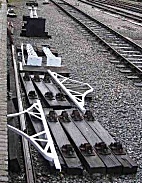
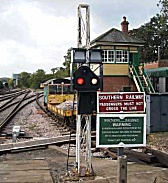
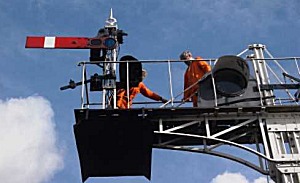
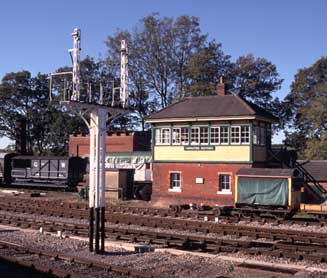
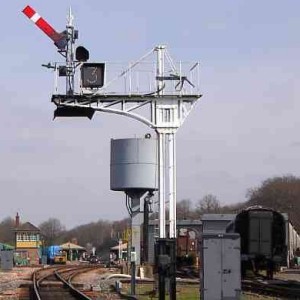 Work continued throughout the winter on the
replacement route indicator for the Up Inner Home Signal
Work continued throughout the winter on the
replacement route indicator for the Up Inner Home Signal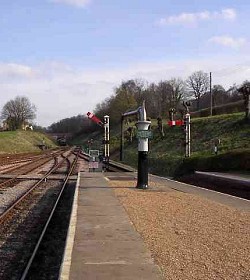
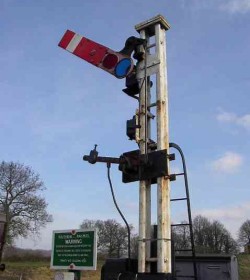
 The picture on right is of the temporary panel
switches inside Horsted Keynes Signalbox which are controlling the points and
signals until such time as the lever frame is re-commissioned. The route is set
for, and all signals are off for, an Up through Train using Nº3 Road.
The picture on right is of the temporary panel
switches inside Horsted Keynes Signalbox which are controlling the points and
signals until such time as the lever frame is re-commissioned. The route is set
for, and all signals are off for, an Up through Train using Nº3 Road.